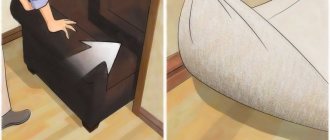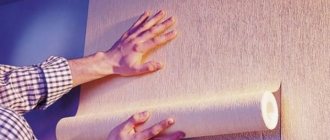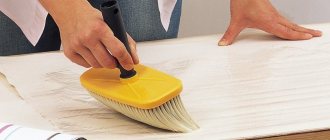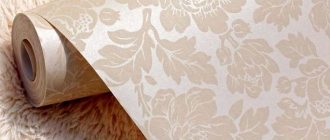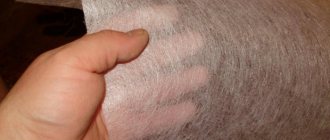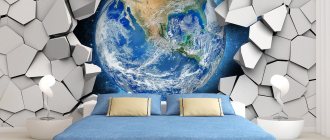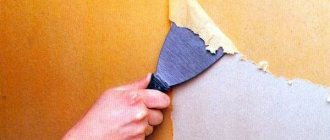Hot-stamped vinyl wallpaper is considered elite-class wallpaper when it comes to vinyl coverings. Their peculiarity is a more labor-intensive production process. Thus, the vinyl coating receives an embossing effect during heat treatment. This expensive procedure allows you to obtain a higher density and better composition. This allows you to clean the surface of the wallpaper with detergents after gluing.
Hot-stamped wallpaper can be glued even in new houses, because... Shrinkage is not a problem for such wallpaper.
Hot-stamped wallpaper is highly wear-resistant to various mechanical impacts and those that pets can exert.
The special strength of the material makes it an ideal solution for houses that have just been put into operation. Such wallpaper will not suffer from cracks due to shrinkage of the house.
What is hot stamping wallpaper?
Hot stamped wallpaper is a double-layer vinyl wallpaper.
- The bottom layer of this type of coating is based on paper or non-woven fabric.
- The base of the top is vinyl.
Under the influence of heat treatment, the top layer melts, forming a dense layer of foam. As a result, the material becomes more elastic, and is ready for the last stage - applying a drawing (pattern) using special figured rollers.
Production development and description of embossed wallpaper
Embossed wallpaper is a type of wallpaper with a textured surface. Quite often, under embossed wallpaper, two-layer paper wallpaper is assumed, the top layer of which has undergone special processing.
Embossed wallpaper got its name thanks to the technological process that is used to develop such wallpaper. Depending on the base of the material, when making a relief pattern, dry, wet, hot or chemical embossing can be used.
Development of production of embossed wallpaper includes the following stages:
- Performing intaglio printing. Good printing allows you to transfer narrow color transitions onto paper, creating the illusion of the reality of the image.
- Product lamination. The wallpaper base (inner layer) is glued to the top layer with special glue.
- Embossing. Glued wallpaper in a wet state is passed through an active (upper) metal shaft and a passive (lower) cardboard shaft. The profile of the upper shaft determines the texture of the finished product.
- The paper strips are firmly fastened together, and the surface of the wallpaper receives a suitable texture.
- Drying the product.
- The material is passed through special trays, where the wallpaper is cut into strips of suitable length.
- Roll forming and packaging.
Embossed wallpaper is considered more measured (low stretch when applying glue) and stronger than cardboard wallpaper
At the moment, embossed wallpaper is made not only on a thick cardboard base, but also on non-woven fabric; polyvinyl chloride treatments are used, which improve the performance properties of the finishing material. The technology for creating such wallpaper differs from that discussed above.
Advantages and disadvantages
Let's consider the advantages of this coating.
- Long service life. Paper wallpaper will serve you for at least 8-12 years, its non-woven counterpart - from 20 years.
- Moisture resistance. This wallpaper is “not afraid of moisture.” They can be used both when finishing the kitchen area and the corridor.
- Easy to care for. You can even use a regular kitchen sponge and dishwashing detergent to clean wallpaper. You can use a damp towel to remove any dust accumulated on the drawing.
- Resistant to direct sunlight. Hot stamped wallpaper does not fade or fade in the sun.
- Soundproofing. The non-woven fabric at the base of the covering and the porous shape of the wallpaper conceal sounds.
- Visually straighten crooked walls. A three-dimensional pattern on the wallpaper allows you to hide small unevenness on the wall.
- Quite a varied selection of textures.
Let's also pay attention to the disadvantages:
- Unresistant to mechanical stress. Due to its rough surface, the three-dimensional pattern does not “tolerate” children, animals, or children’s vehicles well.
- Artificial base. Due to the fact that vinyl is not a natural material, its quality characteristics in terms of environmental friendliness and toxicity are inferior to conventional paper wallpaper.
- The walls don't "breathe". The dense layer of vinyl in the base significantly slows down the ventilation of air between the wall and the covering, which is likely to lead to the formation of mold.
- Difficulties with gluing. Thanks to the double layer, hot-stamped wallpaper has a decent weight, which complicates the gluing process.
- Price. The price range for such coverage is quite wide. For really high-quality wallpaper you will have to pay a lot. Please note that you should not save on non-woven fabrics. However, the price of paper wallpaper fluctuates around 500 rubles. per roll.
Features of embossed wallpaper on a non-woven base
The non-woven backing of embossed wallpaper is made up of cellulose fibers bonded together with a polymer. Non-woven fabric is durable, abrasion resistant and not as easily flammable as paper.
Often embossed non-woven wallpaper with vinyl coating is embossed wallpaper for painting. They withstand repeated painting, and the relief of the coating remains constant.
Embossed non-woven wallpaper has the following advantages:
- Possibility of masking small cracks and unevenness of the wall;
- Fire safety;
- Almost always, rolls of non-woven wallpaper have a large width, which simplifies and speeds up the process of gluing them;
- Easy to maintain - can be carried out with wet cleaning;
- Paintable wallpaper can be repainted a huge number of times;
- During the renovation, the vinyl layer can be separated from the interlining, and new wallpaper can be glued to the remaining base.
The disadvantages of embossed wallpaper on a non-woven base are the same as those of wallpaper with warm or inhibited embossing - high cost and an obstacle to ordinary air exchange.
Types of hot stamping wallpaper
Among the many options for this coating, the following varieties can be distinguished.
- Silkscreen printing . This coating is quite thin, which is explained by a small layer of polyvinyl chloride. Silk-screen printing allows you to create a three-dimensional effect due to silk fabric and shimmer with sparkles. However, it is suitable for a room with perfectly smooth walls.
- Contact vinyl . The exact opposite of silk-screen printing - the vinyl layer is quite thick, which adds significant weight to the coating. Contact vinyl has a relief structure, thanks to which it can imitate brick, fabric, leather and other natural materials.
- Double layer vinyl (heavy vinyl) . Much denser than contact vinyl and has a pronounced pattern.
- Chemical embossing. A special agent, inhibitors, is applied to the vinyl layer along the outline of the pattern, resulting in the formation of a three-dimensional pattern on the wallpaper.
Foam wallpaper
Wallpaper companies are constantly introducing innovations and new solutions, despite the fact that the wallpaper production process is well established. They create new types of finishing materials for walls.
The beautiful and voluminous appearance of foam wallpaper is achieved by pressing out a stencil. The vinyl layers are processed at very high temperatures. The substance begins to evaporate and this causes bubbles and pores to form on the surface, and the cavity of the material becomes airy and thick. This is what gave them their name - foamed.
Foamed vinyl wallpaper has a textured surface. The photo shows how voluminous the texture looks. In appearance, vinyl wallpaper seems heavy, but in reality this is not at all the case. This impression is conveyed by the embossed structure. In appearance, in places where foaming occurs, the surface is always fragile, which makes them not very durable. So, this can be attributed to their disadvantage.
Firmly textured vinyl is called heavy vinyl.
It was named so because of its density and heaviness. In its production, heat treatment is used - vinyl is evaporated. This prevents harmful substances from remaining in the wallpaper structure. The appearance of this material may include imitation of stone, textiles and watercolors. When manufactured, wallpaper of this type becomes like leather.
Looking at the photo of the interior of a room using vinyl wallpaper, one can note that their appearance is much more interesting, which was the beginning of the displacement of paper ones. New products include foam wallpaper. You can see from their texture in the photo how much more voluminous they look. Their base can be non-woven fabric, vinyl or paper. They have excellent decorative properties and a long service life. This is their main advantage. In addition, it should be noted that the price for them is not high.
In order for the walls of offices, shops, houses or apartments to look cozy, you need to choose wallpaper that matches the design solution. Then you can use not only neutral wall decoration. Example in the photo below:
Look at the photo below at how bright the design and splendor of the form are on vinyl wallpaper with a non-woven base. The glitter added to the acrylic foam shimmers very original under the rays of light. The only downside to glitter is that it can fall off the wall. In this regard, it is not advisable to use them to decorate the kitchen and hallway.
Color palette
Hot stamping wallpaper is rich in textures and patterns. For example, contact vinyl is more often used as an imitation of natural materials - wood, leather, brick.
In turn, among the colors of heavy vinyl, bright shades predominate. Iridescent silk-screen printing is characterized by bed pastel colors, sophisticated patterns, and monograms.
Read about fashion trends in wallpaper for walls here -
Cutting out the "duplex" wallpaper
If embossed paper wallpaper is intended for painting, then it has an ornament (embossing) that does not require matching on adjacent canvases. But, if a pattern is industrially applied to embossed wallpaper, then adjusting the stripes is necessary in most cases.
To do this, after checking, before unpacking the wallpaper roll, the batch number and the visual match in color and tone, simultaneously open two rolls and roll them out on a clean, flat surface so that the stripes are located next to each other.
After this, the pattern on both strips is combined and the upper edge of both strips (sometimes one) is cut off. Measure the width of the cut strip (this width is called repeat).
Measure the length of the strip exactly corresponding to the height of the room (no need to leave any allowances!). During the process of soaking and soaking with glue, the length of the wallpaper will increase and they will require slight trimming along the floor surface.
In the future, you can roll out the wallpaper along the “standard” first strip with the pattern facing up, or use a construction tape measure and measure the length of the strips, taking into account the repeat for each subsequent roll.
Before cutting, I fold heavy wallpaper in half, so that the edges are strictly parallel. After this, the bend is strongly smoothed with fingers or a smooth round object (knife handle), and only after that, holding the knife at an angle of 30-35° to the cutting plane, the strip is cut off with small translational movements.
Using scissors is inconvenient and time-consuming. Never use a retractable construction (stationery) knife with replaceable blades when cutting. They are too sharp. They can easily cut the canvas crookedly, ruining 2 whole stripes. The best option is a long kitchen knife with a thin blade, sharpened with a file before cutting.
Gluing process
In the process of covering walls, it is important to consider several points. Firstly, it is the heavy weight of the wallpaper (in the case of contact vinyl and heavy vinyl). Secondly, you need to glue joint to joint, especially if there is a pattern on the wallpaper.
Please note that the success of covering vinyl wallpaper directly depends on the preliminary preparation of the wall: it must be dry and clean. Before gluing, it is advisable to remove the baseboard, switches and sockets. Always start gluing from the corner. Cut off excess pieces with a well-sharpened tool.
Analysis of the process of pasting embossed “duplex” wallpaper
Embossed “duplex” wallpaper is one of the varieties of paper wallpaper that belongs to the “heavy” group. A characteristic feature of the embossed “duplex” is the structure of the canvas, which consists of 2-3 layers of paper of varying density and thickness. Often, as a third layer, it has a layer of fine wood dust or non-woven viscose fiber. Due to the volume of which the ability to retain its shape when dried. During the production process, embossing is applied to the surface by pressing various reliefs that can imitate floral patterns or the texture of various finishing materials - stone, wood, or floral patterns. Faced with this type of wallpaper for the first time, many people have a question: how to stick embossed duplex paper wallpaper? Will they lose their characteristic embossing texture during the gluing process?
To do this, there are a number of rules, following which you can be sure of maintaining the relief and integrity of the top layer.
The best manufacturers
One of the leaders in the production of hot-stamped wallpaper is Germany, namely such companies as AS Creation, Rasch and Erismann.
Italy is practically not inferior to its European neighbor - the Zambaiti and Sirpi brands are worthy competitors in the world market.
The Ukrainian factory "Eden" produces vinyl wallpaper of European quality.
Among domestic manufacturers you can find “Erisman”, “Elysium”.
How to glue vinyl wallpaper
Before asking the question of how exactly it is necessary to glue vinyl wallpaper, you need to accurately determine the type that will be preferred for the design of the future interior.
So, each type of wallpaper using vinyl requires a different complexity of pre-treatment of the wall surface. In fact, the gluing process includes several simple steps, which can be seen in the following video.
If you have any questions, you can contact the consultants of the StroyDekor online store. We specialize not only in providing a wide range of these products, but also in convenient service and payment systems. The company's managers will provide detailed advice on the selection of certain wallpaper coverings, as well as on the selection of impregnations necessary for their pre-treatment.
In the interior of different rooms
Hot stamping wallpaper is perfect for the design of any room. For example, pastel colors of silk-screen printing will decorate the bedroom, and patterns and monograms will add tenderness and sophistication to the room. However, dark compact vinyl will provide a more relaxed atmosphere in the room.
The nursery and kitchen will be decorated with bright colors such as yellow, green, pink, turquoise, blue. However, it is better to combine several shades. For the kitchen, you can also use imitation stone or brickwork.
In the living room, the best option would be a predominance of metallic tones, which in turn will give the room a sense of conceptuality and spaciousness. Stylized furniture is an ideal complement.
Learn more about wallpaper for the living room.
Comparison of two groups of embossed wallpaper
The technical characteristics of thick embossed wallpaper are based on the base used (non-woven fabric and paper). This is a major factor affecting price, quality and durability. Let's look at each category.
Nonwoven
Let's consider the advantages of roll sheets and the existing disadvantages.
New embossing technologies make wallpaper extraordinarily beautiful
Pros:
- Safety. This wallpaper is absolutely safe for humans. They do not contain harmful substances and are recommended for all types of rooms, including bedrooms. Indispensable in apartments with children and allergy sufferers.
- The “breathability” of the coating has been proven . They allow air to pass through and eliminate the possibility of mold and mildew.
- Quality . Thanks to its composition, the material does not deform after application and retains its color saturation for many years.
- Design. The variety of textures, patterns and palettes attract attention. Non-woven wallpaper can decorate any interior and hide defects on complex surfaces (except for silk-screen printing).
Silkscreen printing impresses with the play of color
- Decorating possibilities . Many types can be painted. Under the influence of paint, the base does not change, but the structure becomes denser.
- Versatility. Wallpaper with embossing is suitable for walls made of plasterboard, chipboard, wood and concrete.
- Dismantling. No soaking or scraping required. The canvas is easily separated from any surface.
- Quick installation (roll width is one meter).
- Long service life - 9–12 years.
Vinyl embossing offers a large selection of designs
Minuses:
The number of strengths can be compared with the only disadvantage. Vinyl wallpaper that does not have additional coating (varnish, paint) cannot be washed. Dry cleaning with a vacuum cleaner is acceptable.
Non-woven wallpaper is much more expensive than paper wallpaper. To save money, it is recommended to use a small pattern in large rooms. Otherwise, each roll will take 1–2 meters to pick up.
Non-woven base is moisture resistant - used in the bathroom
Paper
Paper-based embossed vinyl has its strengths and weaknesses. In general, this group loses to non-woven ones. Heavy vinyl (duplex) is considered the highest quality.
Advantages:
- Minor camouflage effect (small cracks, roughness).
- Contribute to the creation of a favorable microclimate.
- Environmentally friendly.
- Not exposed to UV rays.
- Low price.
Flaws:
- Can't be washed.
- Cannot be used in damp areas.
- Low resistance to stains.
- With increased parking, mold/fungus appears on the paper.
- Difficult installation - you need to apply glue to the canvas and the wall. There are a lot of seams, since the rolls are 53 cm long.
- Short service life - 5 years.
Photo collection
A few more gluing options that you can do at home.
Tips and tricks
It is not difficult to wallpaper a duplex . Even a person with no experience in such work can cope with this. To get a high-quality result, consider the following recommendations:
- The correct room temperature is important for drying canvases. You need to close doors and windows to protect the wallpaper from drafts. Elevated temperatures can also be dangerous; heaters should not be used.
- New canvases cannot be glued to old wallpaper (how to tear off old wallpaper?). In the future, new material will begin to come off, which will spoil the whole picture.
- You should not paste over the corners with a solid canvas (how to glue wallpaper in the corners of a room?). They are glued either end-to-end or overlapping.
- In order for the canvas to stick without bubbles, you need to press it well against the wall and smooth it with a roller from the middle to the edges. Small bubbles usually go away on their own after drying. If there is a large bubble left on the papered walls, you can use a syringe to inject a small amount of adhesive solution into it. After smoothing, the protruding excess glue is removed with a rag or dry sponge. Read more about how to glue wallpaper without bubbles in another article.
- It is important not to apply excessive amounts of adhesive. It will be difficult to remove it on paper coverings.
Duplex wallpaper is a winning solution for almost any interior . It's easy to glue them on. The main thing is to take into account all the rules and prepare the surface well.
Advantages and disadvantages
Attention:
Embossed fabrics are made from different combinations of materials and have different properties. Each category has its own pros and cons.
Pros and cons of duplex paper materials:
| pros | Minuses |
|
|
Pros and cons of vinyl:
| pros | Minuses |
|
|





